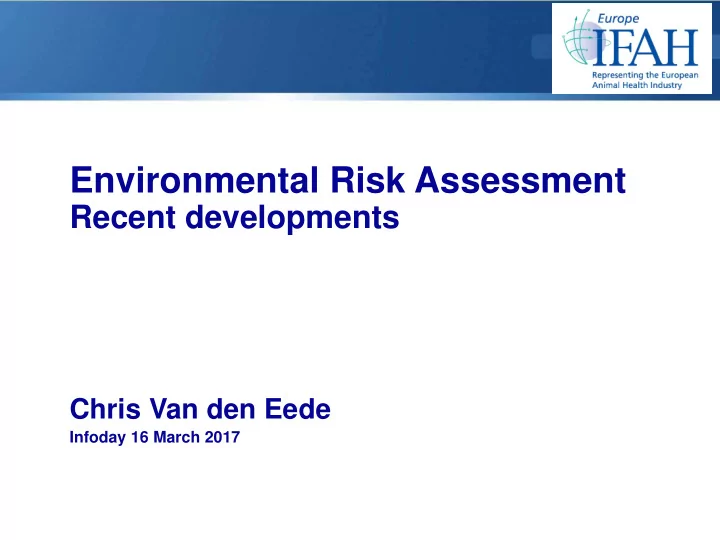

Environmental Risk Assessment Recent developments Chris Van den Eede Infoday 16 March 2017
• From the start: an area of constant change VICH/TGD: predictability and harmonisation on the technical side • (2000, 2004, 2008) BUT: legislation under revision AND: additional guidance documents
Overview Recent developments: • PBT-assessment • Higher Tier dung fauna testing • Legislative review – Proposals under discussion 3
PBT - CCC Guideline in place, Reflection Paper under development Current concepts • Substance, not product • Hazard-based • Phasing-out • Comparative assessment and substitution These concepts have been captured in EP-amendments 4
PBT - CC Concerns • Scope? • Substance-based approvals prior to submission of MAA? • Extra legislation? • Need clinical trials to demonstrate therapeutic benefits ? • Exposure not considered - Risk assessment not accepted? • Hazard/benefit assessment? • Criteria for product approval? • What with substances shared with human medicine? 5
PBT - C Consequences • Uncertainties regarding existing products • Decisions driven by hazard, not risk • High hurdle for future (parasiticide) development for EU • Note: not all parasiticides are PBT • Anthelmintic resistance? • Animal health and welfare? 6
Dung fauna Higher Tier testing (1) • High need for a way forward • Support for proposed tiered approach • Tier A: (spiked) dung laboratory studies, EC 50 • Tier B: 2 studies mentioned, NOEC • “methodologies under development” – dung beetle only • no validation • Focus of draft GL: field studies in Tier C, duration of effects • Very prescriptive, rigid protocol proposal • Need for multiple studies within Europe • Not following DOTTS* validation work intended for OECD • Scientific justification for 28 day decision point criteria? • Knocks out avermectins, pyrethroids,… * Dung Organism Toxicity Testing Standardisation 7
Dung fauna Higher Tier testing (2) Recommendations • Suggestion to keep guidance and study protocols separate • Proposal to explore: • Development and validation of proposed Tier B studies (OECD) • Tier B dung flies? More sensitive than beetles • Additional studies with incurred residues in Tier A/B, duration of effects • If high and prolonged effects, then proceed with field study • Refinement and validation of proposed Tier C study (OECD) as recommended by the DOTTS group: Floate et al (2016). Validation of a standard field test method in four countries to assess the toxicity of residues in dung of cattle treated with veterinary medicinal products. Envir. Toxicol. Chem 35 (8), 1934– 1946 Tixier et al (2016). A four-country ring test of non-target effects of ivermectin residues on the function of coprophilous communities of arthropods in breaking down livestock dung. Envir. Toxicol. Chem 35 (8), 1953-1958. Jochmann et al (2016). A field test of the effect of spiked ivermectin concentrations on the biodiversity of coprophagous dung insects in Switzerland. Envir. Toxicol. Chem 35 (8), 1947-1952. 8
Legislative review Proposals (1) • Generics (COM) • ERA when reference VMP registered before 20 July 2000 or in case Phase II assessment required for the reference VMP • SPC-harmonisation (COM) • ERA when registered before 20 July 2000 or reassessment if identified earlier as potentially harmful • Monographs (EP) • Separate legislation - mechanism unclear • Required for all substances or just food-producing animals? • Only covers hazards = substance; exposure determines risk = product • Product database (COM, EP) • Environmental data to be included
Legislative review Proposals (2) • Refusal if: (EP) • Substance of high concern • Persistent, bioaccumulative and toxic (PBT) • Endocrine disruptor • Higher risk compared to “standard reference treatment” • Comparative assessment and substitution • No protection of technical documentation (EP) • “ Safety information with regard to the environmental effects of veterinary medicinal products shall not be protected.” • Manufacturing (EP) • Details on emissions, discharges, losses to be included in product dossier • Manufacturing authorisation refused if unacceptable risks • Risk for AMR during production and use
Consequences Legislation/Guidelines • Moving away from harmonised approach under VICH: • PBT testing even if the assessment ends in Phase I • Dung fauna testing: EU vs other regions • Moving from risk assessment to decisions on a hazard • Monographs: list of hazards – who owns them, who pays? • Substance-based approvals: based on the hazards, not risks • Impact on medicines availability? • Lack of predictability – right now • Re-assessment of existing products: who pays? • Development of new products for food-producing animals: who dares? • Proportionality?
The way forward • Maintain the existing product-based benefit-risk assessment, rather than a substance- and hazard-based approach • Ensure environmental risk assessments to be proportionate and performed according to internationally validated and adopted standards • Foster a healthy culture of dialogue and scientific information exchange 12
Thank you 13
Recommend
More recommend